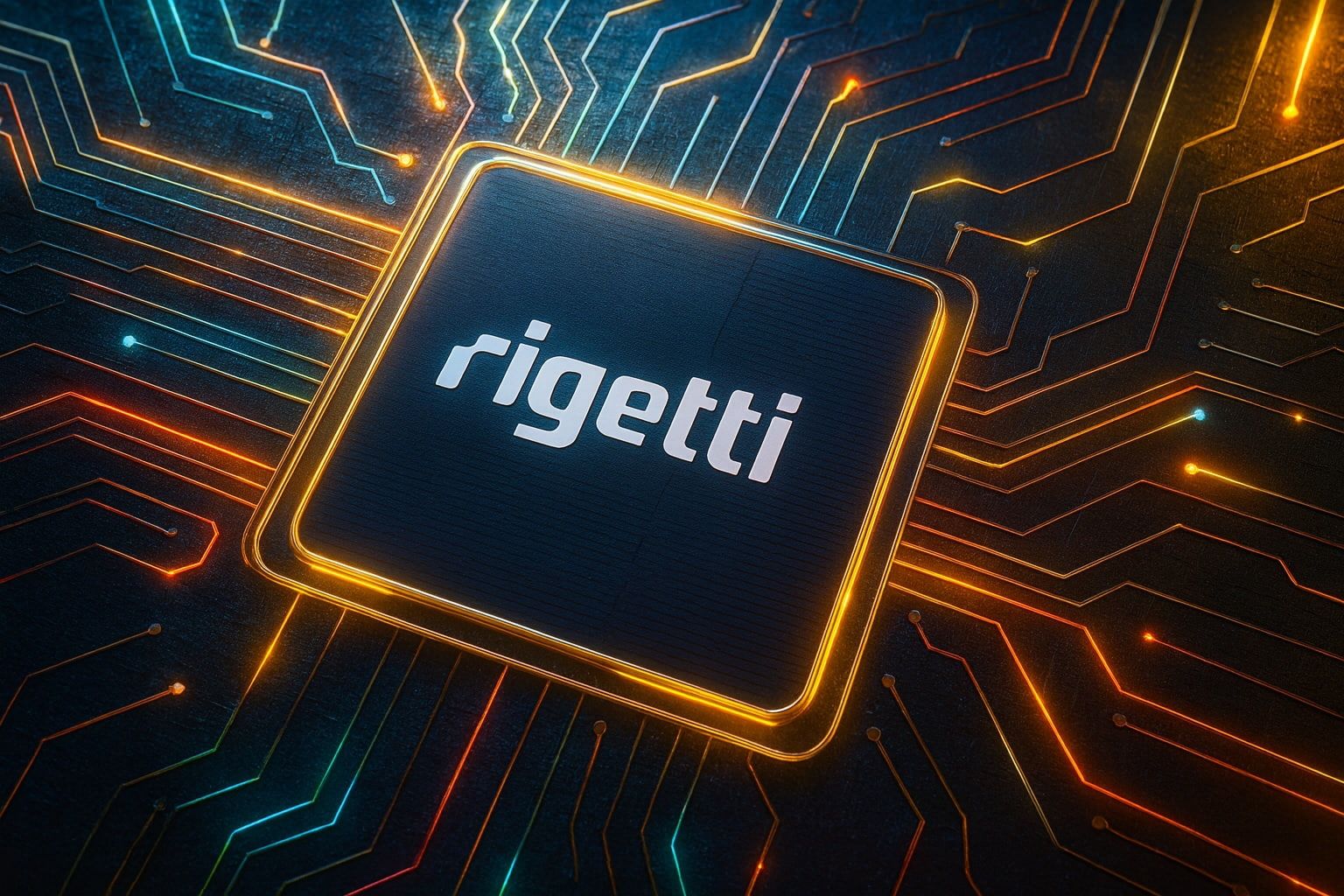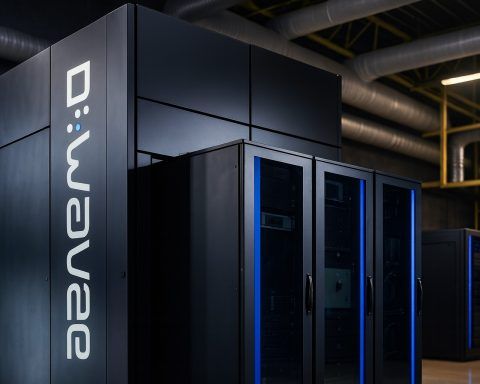- Stock parabolic: Rigetti Computing (NASDAQ: RGTI) has seen a breathtaking surge, rising roughly 50× from under $1 to a peak near $56 in mid-October 2025 [1] [2]. As of Oct. 24, RGTI closed around $39 (down ~2% that day) after extreme volatility [3] [4]. The 52-week range spans from mere cents to nearly $60, reflecting an extraordinary roller-coaster ride [5] [6].
- Big deals & tech wins: Recent contract wins have fueled the rally. In late Sept 2025 Rigetti (with partner QphoX) won a $5.8 million U.S. Air Force quantum networking contract and simultaneously booked ~$5.7M in orders for two new Novera quantum computers [7] [8]. The company also rolled out a next-gen 36-qubit “Cepheus” processor on its cloud platform [9]. These milestones – Rigetti’s first major hardware sales – stoked investor optimism that the company is delivering on its roadmap [10] [11].
- Government buzz: On Oct. 22 a Wall Street Journal report said the U.S. Commerce Dept. may take ~$10M equity stakes in quantum firms (including Rigetti, IonQ, D-Wave) to bolster R&D [12] [13]. Rigetti’s stock jumped double-digits on the rumor, but a Commerce official then clarified the department was “not currently negotiating with any” such deals [14] [15]. The episode underscored how strategic quantum computing has become (as IG Markets analyst Chris Beauchamp noted, it “offers the chance to really revolutionize the U.S. economy” [16]), but also reminded markets not to get carried away by unconfirmed news.
- Wall Street outlook: Virtually all analysts rate RGTI a “Buy” (reflecting excitement about its long-term quantum potential) [17]. However, consensus 12-month price targets remain far below current levels – typically in the $20–30 range (about 50% under today’s price) [18] [19]. In other words, even bullish firms warn the stock may be overextended. As one veteran fund manager put it: “Valuations are ahead of themselves, but that’s part of investing in the future… The signs of commercial traction are definitely worth monitoring.” [20]
- Extreme valuation vs. revenue: Rigetti now sports a ~$15–18 billion market cap, yet annual sales are only on the order of $8–10 million [21]. That works out to an eye-popping ~1,500× sales multiple [22]. Analysts openly caution that this disconnect resembles past bubbles. CNBC’s Jim Cramer (who initially scoffed at RGTI) recently said “quantum computing is for real” and Rigetti “could have something that’s a home run,” but he also bluntly called Rigetti “pure speculation” at current prices [23].
- Peers in motion: RGTI isn’t alone in its jumpy ride. Fellow “quantum four” stocks have also soared. IonQ is up on the order of +270% year-to-date and D-Wave up thousands of percent [24], but even those gains are dwarfed by RGTI’s ~2,800% rise [25]. (By comparison, pure-play fintech or AI stocks have not seen such extreme moves this year.) Big tech players like IBM, Google and Microsoft haven’t seen their stocks spike, but they are aggressively advancing quantum R&D (e.g. IBM’s record-breaking qubit chips and Microsoft’s Azure Quantum platform) to stay competitive [26] [27].
- Investor sentiment and risks: Retail and spec funds have piled in on the promise of “quantum supremacy,” but institutional veterans are more circumspect. Insiders at Rigetti have quietly sold stock (CEO Kulkarni sold his entire stake earlier in 2025 [28] [29]), and some hedge funds warn of steep corrections ahead. Morgan Stanley’s analyst Joseph Moore has warned RGTI could tumble “by up to ~60%” if frothy sentiment sours [30]. Barron’s and others have likened the current run-up to a hype-driven bubble that will eventually be “tested by fundamentals” [31] [32]. On the upside, proponents note that Rigetti’s heavy gov’t contracts and partnerships (with QphoX, Nvidia, Microsoft Azure, etc.) give it credibility that pure research startups lack [33] [34].
Rigetti’s stock chart has resembled a rocket ship: exploding out of penny-stock territory to multi-billion-dollar market cap in 2025. Experts stress that the company needs to start matching hype with revenue growth to sustain this valuation [35] [36].
Market Mania: Parabolic Rise and Recent Pullback
Rigetti’s stock journey in 2025 has been nothing short of extraordinary. At the start of the year RGTI traded below $1; by Oct. 15 it hit an all-time high around $56.34 [37]. (For context, TS2 notes that “all-time high of around $56” after a ~5,000% rally [38].) However, after peaking in mid-October the stock has been sliding. By Oct. 21 RGTI was trading in the mid-$40s [39], down roughly 25% from its peak. As of Oct. 24 it closed near $39 [40]. Notably, no new bad news from Rigetti’s business triggered the sell-off – rather, traders attribute it to broader market jitters and classic profit-taking after such a frenzied run [41] [42]. In essence, RGTI’s chart looks like a rocket launch with a steep climb and a volatile wobble on the way down.
Recent News and Breakthroughs
The surge was propelled by a steady stream of positive developments. In late Sept. 2025 Rigetti announced two headline wins: a $5.8M multi-year contract from the U.S. Air Force Research Lab (in partnership with Dutch firm QphoX) to build advanced quantum networks, and roughly $5.7M in orders for two of its new “Novera” quantum computing systems slated for delivery in 2026 [43] [44]. These were Rigetti’s first significant product sales, and management highlighted their significance for validating the technology. For example, Rigetti’s CEO Subodh Kulkarni said AFRL’s commitment “advance[s] superconducting quantum networking,” helping keep the U.S. at the forefront of quantum R&D [45] [46]. Around the same time Rigetti unveiled a 36-qubit “Cepheus” processor on its cloud platform [47] [48], again underscoring real technical progress (Rigetti claims ~99.5% two-qubit fidelity on this new chip [49]).
Meanwhile, macro-news also moved the needle. A Wall Street Journal scoop on Oct. 22 suggested the Trump administration would take equity stakes in quantum startups (Rigetti included) to secure the technology supply chain [50]. Stocks of IonQ, D-Wave and Rigetti all jumped in pre-market trading on the rumor [51], though a Commerce Dept. spokesperson quickly denied any active talks [52]. The incident illustrates how heavily quantum companies are riding a wave of national-security interest – but it also shows how speculative such news can be.
Financial Outlook & Analyst Commentary
Despite the headline success, fundamental investors are cautious. Analysts point out that current valuations are built on very optimistic assumptions. Rigetti’s 2024 revenue was only in the single-digit millions, so banks point out it has virtually no near-term profit pathway [53]. All the major analysts still rate RGTI “Buy” (since few want to miss out if quantum takes off) [54], but even so their price targets cluster far below the market. For example, TS2 reports average one-year targets in the mid-$20s for RGTI [55] – roughly half today’s price. Benchmark Capital in October did raise its target to $50 [56], but most firms stayed conservative. Seeking Alpha notes one analyst calling RGTI “massively overvalued” given its ~$17–18B market cap versus tiny revenue [57].
Experts warn that investors are essentially “pricing in a future” where Rigetti nails all its big goals [58]. Morgan Stanley’s Joseph Moore even predicted RGTI could “fall by up to ~60%” if the sector’s hype fades or if there’s any disappointment [59]. Likewise, CNBC’s Jim Cramer – who flipped bullish on quantum – echoed the mixed sentiment: “quantum computing is for real” and Rigetti could “have something… a home run,” yet he conceded RGTI is “pure speculation” at these prices [60]. In short, analysts love the vision but stress that execution is critical. Rigetti must prove it can hit technical milestones (like a promised 100+ qubit system by end-2025) and start growing revenue before the stock’s stratospheric valuation can be justified [61] [62].
Technology Partnerships and Roadmap
Rigetti’s strength lies in its tech stack and alliances. It operates its own chip fabrication fab and offers a full-stack quantum cloud service. The company partners with industry leaders – for instance, its machines are available through Microsoft’s Azure Quantum platform, and it collaborates with NVIDIA on quantum algorithms [63]. It’s also working with QuTech (Delft) and other labs on error-correction research. These partnerships give Rigetti scale and credibility that most tiny startups lack [64].
On the tech front, the Cepheus 36-qubit chip released in late 2025 is a concrete advance. (TS2 notes it achieved ~99.5% two-qubit gate fidelity [65] – on par with top standards.) Rigetti still trails IBM and Honeywell in sheer qubit count, but its qubits are competitive in fidelity. CEO Kulkarni often cites parallels to early Palantir: focusing first on government contracts (e.g. DARPA, AFRL) to fund R&D, then spinning that momentum into enterprise products over time [66]. In that light, Rigetti’s backing by DARPA and now the Air Force could be seen as a strategic springboard.
Looking ahead, Rigetti plans to unveil a >100‑qubit system within the next year. If achieved, that would be a major milestone – but skeptics note it’s a tall order. The big question: can Rigetti’s hardware solve real problems better than classical systems? Trials like HSBC executing bond trades on quantum prototypes and Vanguard running quantum portfolio tests suggest interest is growing [67], but mainstream enterprise adoption is still nascent.
Quantum computing is part of a broader tech boom. Peers like IonQ (trapped ions) and D-Wave (quantum annealing) have also seen stock rally, and even legacy giants (IBM, Google, Microsoft) are doubling down. This ensures that if and when quantum yields commercial breakthroughs, early players like Rigetti could benefit – but right now the industry is in a speculative ’supercycle’ phase as investors try to pick tomorrow’s leaders [68] [69].
Peer Comparison
Among pure-play rivals, IonQ and D-Wave have also enjoyed monster gains in 2025. By mid-October, IonQ (IONQ) was trading in the $50–60 range (up ~+269% YTD) and D-Wave (QBTS) over $30 (up +2,000%+) [70] [71]. However, Rigetti’s ~2,800% jump still vastly outpaces them [72] [73]. IBM and Google, which have in-house quantum divisions, haven’t had similar stock moves (their businesses are diversified), but they recently reported breakthroughs (IBM’s new error-corrected chip and Google’s AI+quantum advances) that reinforce the industry’s momentum.
In sector sentiment, Wall Street says all these stocks are “strong buys” overall [74], since the long-term potential is huge. TipRanks shows nearly all analysts bullish on IonQ, Rigetti and D-Wave [75]. Price targets for IonQ are sometimes as high as ~$80–100, while some have put Rigetti’s at ~$50 [76] (still below current levels). Smart investors note, however, that the bull-case for Rigetti depends on it delivering multi-qubit systems and real business utility before the hype runs out [77] [78].
Public and Institutional Sentiment
On social media and trading boards, Rigetti is seen as a “moonshot” bet. There’s noticeable retail enthusiasm – akin to past tech mania – as ordinary investors FOMO into $RGTI after hearing a 5,000% move. Institutional players have been cautious but intrigued. For example, JPMorgan recently announced it is pouring $1.5 trillion into growth areas including quantum computing [79]. Renowned long-term investors (e.g. Bill Miller, an early Rigetti backer) have watched the rise closely – Miller has publicly noted quantum’s promise, though he also cautions about hype. Reuters observes that even bond traders (like HSBC and Vanguard) are testing quantum tools, which signals growing interest from conservative cornerstones of finance [80].
But some see red flags: several board members and executives sold shares during the peak rally [81], and with limited free float, the stock has tended to gap up or down on any news. Overall, polls of quantum investors suggest excitement is tempered by fear of a pullback. As one tech columnist warned, “this quantum frenzy may keep inflating until it is tested by fundamentals.” [82].
Risks and Controversies
The biggest risk is valuation. At 1,500× sales, any slip in expectations could lead to a sharp correction. Rigetti has not warned of cash shortages – it reported ~$300M cash on hand mid-2025 – but if it doesn’t soon turn prototype deals into recurring revenue, analysts say the gap between price and profits will become untenable [83] [84]. Regulatory risk is modest, though as a defense contractor it must meet export controls on cryptography-related tech; no legal controversies have been reported. The main “controversy” is simply whether this is the start of the quantum revolution or an echo of dot-com euphoria. Some veteran investors (including famed bear Jeremy Grantham) caution that new tech often triggers exponential mispricings before fundamentals catch up [85].
In summary, Rigetti is at the eye of a storm. It has real technology and is winning contracts, but it also has billions of dollars of expectations built into its share price. Its stock may keep churning violently until it proves that future earnings justify its meteoric rise. For now, every new partnership or product launch is cheered – yet each will be scrutinized for signs that “quantum” is finally delivering on its promise [86] [87].
Sources: Insider media and financial sites (including TechStock²/TS2.tech [88] [89]), Reuters [90] [91], CNBC interviews, company press releases, and market data (Yahoo Finance, Finviz [92] [93]). All information is up-to-date as of Oct. 27, 2025.
References
1. ts2.tech, 2. stockanalysis.com, 3. stockanalysis.com, 4. ts2.tech, 5. ts2.tech, 6. stockanalysis.com, 7. ts2.tech, 8. thequantuminsider.com, 9. ts2.tech, 10. ts2.tech, 11. thequantuminsider.com, 12. ts2.tech, 13. www.reuters.com, 14. ts2.tech, 15. www.reuters.com, 16. ts2.tech, 17. ts2.tech, 18. ts2.tech, 19. ts2.tech, 20. ts2.tech, 21. ts2.tech, 22. ts2.tech, 23. ts2.tech, 24. ts2.tech, 25. ts2.tech, 26. ts2.tech, 27. ts2.tech, 28. ts2.tech, 29. ts2.tech, 30. ts2.tech, 31. ts2.tech, 32. ts2.tech, 33. ts2.tech, 34. thequantuminsider.com, 35. ts2.tech, 36. ts2.tech, 37. ts2.tech, 38. ts2.tech, 39. ts2.tech, 40. stockanalysis.com, 41. ts2.tech, 42. ts2.tech, 43. ts2.tech, 44. quantumcomputingreport.com, 45. thequantuminsider.com, 46. quantumcomputingreport.com, 47. ts2.tech, 48. quantumcomputingreport.com, 49. ts2.tech, 50. ts2.tech, 51. ts2.tech, 52. ts2.tech, 53. ts2.tech, 54. ts2.tech, 55. ts2.tech, 56. ts2.tech, 57. ts2.tech, 58. ts2.tech, 59. ts2.tech, 60. ts2.tech, 61. ts2.tech, 62. ts2.tech, 63. ts2.tech, 64. ts2.tech, 65. ts2.tech, 66. ts2.tech, 67. ts2.tech, 68. ts2.tech, 69. ts2.tech, 70. ts2.tech, 71. ts2.tech, 72. ts2.tech, 73. ts2.tech, 74. ts2.tech, 75. ts2.tech, 76. ts2.tech, 77. ts2.tech, 78. ts2.tech, 79. ts2.tech, 80. ts2.tech, 81. ts2.tech, 82. ts2.tech, 83. ts2.tech, 84. ts2.tech, 85. ts2.tech, 86. ts2.tech, 87. ts2.tech, 88. ts2.tech, 89. ts2.tech, 90. www.reuters.com, 91. ts2.tech, 92. stockanalysis.com, 93. ts2.tech





